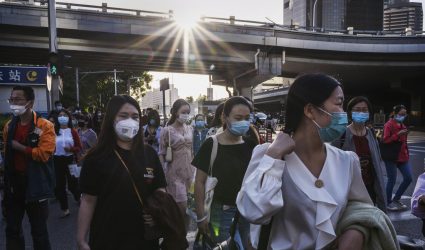China’s Economic Recovery Leaves the Bottom 60% Behind

(Bloomberg) – China doesn’t care about its bottom 60%. The country seems to have bounced back from the Covid-19 slowdown. Exports are growing by double digits, and retail sales, which had been lagging for months, are back to pre-virus levels. With daily life mostly back to normal, the country seems to be humming again.
But poorer households are still struggling. The rebound Beijing engineered is K-shaped, exacerbating widening income inequality, which was already a problem before the pandemic.
Most households in the bottom 60%, or those earning less than 100,000 yuan ($14,650) a year, said their wealth declined in the first half of 2020, the China Household Finance Survey finds. Those earning more than 300,000 yuan a year reported net gains. We get a glimpse of the upper tier’s confidence from sales of luxury items: High-end autos are doing well, and Chanel, Louis Vuitton, and other brands raised prices this year.
This has happened in part because China’s fiscal stimulus is different from that of the U.S. Beijing feels it has more control over businesses than consumers, so it stimulates the economy by building new bullet trains and 5G telecom stations. There are no equivalents to the $1,200 check from Uncle Sam, or the $600-per-week enhanced unemployment benefit from the Treasury Department. China went for trickle-down economics.
The country’s decision to aid business owners rather than workers may have long-term repercussions. Of its 442 million urban workers, more than one-third, or 174 million, are migrants. They mostly work in low-paying jobs in construction, delivery, manufacturing, and restaurant services. When those industries were shut down, migrants not only lost their jobs but also failed to collect unemployment checks. With their hukou, or permanent residency, tied to the rural areas, in Beijing’s books they were never employed in the cities in the first place. They were just going home to farm.
The economic loss borne by the poorest 60% could be as much as 1.35 trillion yuan ($198 billion), estimates Gavekal Dragonomics, a research firm. Some continue to be underemployed. In August, sales from the catering industry, which employs about 12 million migrant workers, were still down 7% from a year earlier.
China’s urban unemployment rate has come down to 5.6% in August from February’s 6.2% high, the statistics bureau proudly proclaimed. This figure is likely a big understatement. Migrant workers are hardly present in the government’s urban survey.
Make China a cautionary tale for Washington. If the political impasse over stimulus continues, the U.S. will end up in the same situation, with the wealthy wondering whether work from home means they should sell their Hermès ties while the poor scramble to survive. A K-shaped recovery is worse than a U- or W-shaped one.

